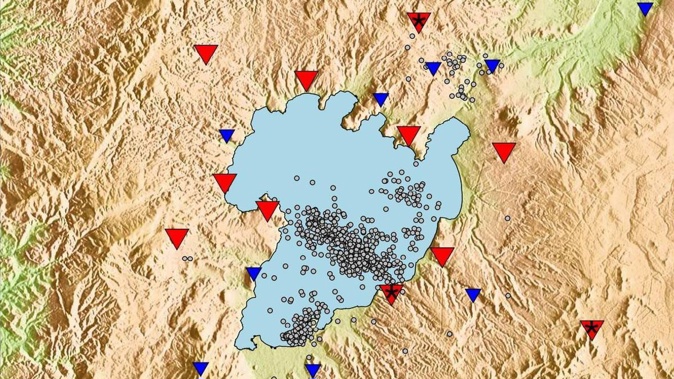
Scientists think they've pin-pointed the location of the magma chamber within the huge Taupō "supervolcano" that lies hidden beneath the lakeside town.
In a just-published study, researchers have detailed how the reservoir appeared to have been revealed by the swelling of an area of ground in 2019, which coincided with thousands of earthquakes around the site.
But they assure people the volcano – which has produced some of the largest eruptions on the planet – is no closer to blowing.
Taupō is a caldera volcano – or a cauldron-like crater – created through its magma chamber being violently emptied out in huge eruptions.
Lake Taupō essentially fills the hole left by one of those monster blows - the Oruanui eruption, around 25,400 years ago, which spewed more than 1100 cubic km of pumice and ash into the atmosphere that travelled as far as Antarctica.
Taupō's most recent major episode - a devastating event 1800 years ago - fired out more than 120 cubic km of pumice and ash and obliterated the surrounding landscape.
While scientists have long known the volcano's magma chamber lies less than 10km below the lake, studying the volcano – and specifically how it interacted with a rift marked by numerous quake-making crustal faults – remained difficult.
"Taupō is an active caldera volcano and, while it hasn't erupted since 232AD, it has undergone periods of historical unrest which can involve large amounts of seismic activity and ground deformation," said Dr Finn Illsley-Kemp, a volcano seismologist at Victoria University.
"It can be challenging to determine whether these unrest periods are due to changes in the volcano itself or simply due to its setting in the active tectonic environment, where the Earth's surface is pulling apart at about 1 cm per year."
In 2019, the number of recorded quakes was far more than the 300 typically counted each year - and many of them happened to hit in the area of volcano covered by the lake.
While most of these were small, one quake recorded on September 4, and centred in the middle of the lake near Motutaiko Island, registered a magnitude of 5.3.
That was enough to cause shaking from Turangi to Taupō, knocking items off shelves and causing highway slips, and was swiftly followed by another quake, measuring 4.5.
"I began noticing that something was different after an earthquake on June 25, which caused heavy shaking in Taupō town and may have led to the rupturing of a sewage pipe on the waterfront," Illsley-Kemp said.
The September 4 quake, that came after many more shakes over July and August, proved the largest recorded under the lake for more than 50 years.
"The combination of large numbers of earthquakes beneath the lake, and their high magnitude told me that this was something different to the normal behavior of Taupo," he said.
"I then began analysing these earthquakes in detail and also looking at the data from GPS stations around the lake, to see if there had been any ground deformation."
The volcano's last comparable episodes played out in 2008, and, before that, between 1997 and 1998.
But this time, earthquake detection software developed at Victoria University – which effectively used quakes as "templates" to search for similar ones of smaller magnitude – was in place to provide a much richer picture of what was happening below ground.
That told them that there hadn't been just 700 quakes around the site over those months - but more than 7000.
"This was important because it allowed us to see how the earthquakes were moving around the subsurface in much more detail - like looking at the unrest in HD."
Further, they found the quakes coincided with the ground beneath the lake swelling.
Again, this was relatively normal behaviour for a volcano like Taupō, and occurred roughly once a decade – but their analysis of the quake locations turned up an interesting pattern.
"We found that there was a region, roughly beneath the Horomatangi Reefs, where there were very few earthquakes - effectively forming a gap."
It happened to be in this "gap" that they'd observed the ground swelling – leading to an exciting finding.
"We think that this region is the location of Taupō's magma reservoir, and that the deep rock here is too hot and partially molten for earthquakes to occur."
Specifically, their results suggested the chamber was at least 20 per cent molten – and spanned an area of 250 cubic kilometres – but knowing its location was a major insight alone.
"This is an important finding for monitoring Taupō, as we now have an idea of where the magma reservoir is and we can now focus our attention on monitoring this area."
In their study, published in the journal Geochemistry, Geophysics, Geosystems, he and colleagues concluded the spate of quakes and ground-swelling was likely caused by new magma being injected into the bottom of the reservoir.
"While we found that Taupō was in a state of volcanic unrest, we saw no evidence which suggested that it was close to eruption," he said.
"However, Taupō will most likely erupt at some stage over the next few thousand years - and so it's important that we monitor and understand these unrest periods so that we can quickly identify any signs which might indicate a forthcoming eruption."
He noted the unrest was only able to be identified with detailed analysis - and some time after the event.
"This shows how challenging it is to monitor Taupō, partly because of the lake, but also because of the size and complexity of the volcano."
He and fellow scientists at Victoria, GNS Science and Massey University are gradually building a clearer understanding of what is the world's most frequently active supervolcano system through the five-year, $8.2m MBIE-funded ECLIPSE project.
Take your Radio, Podcasts and Music with you








